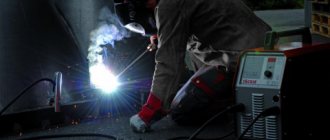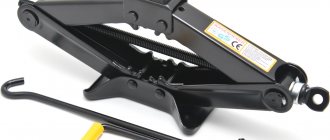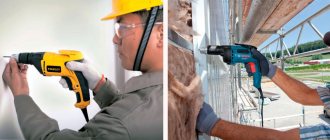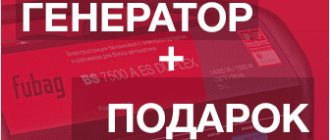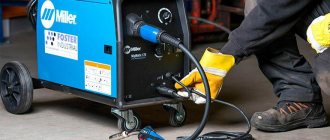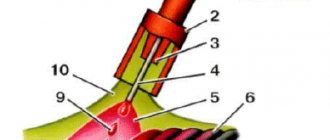Semi-automatic welding makes it possible to increase productivity and quality of work. The equipment does not require the use of traditional electrodes. Instead, a special filler wire is used, which is wound on a reel. The advantage of this approach is that the specialist does not have to tear the seam to change the rod. The operation is performed continuously, maintaining the integrity of the seam and saving time.
In addition, the equipment allows you to weld workpieces of different thicknesses: from 0.2 mm to several centimeters. In this case, the welder can work with workpieces made of different materials or their alloys. In order to take advantage of all the listed advantages, gas is required for semi-automatic welding. It will prevent atmospheric moisture and other elements contained in the air from penetrating into the weld pool.
What gas is needed for semi-automatic welding
The technological regulations for semi-automatic welding provide for the use of inert or active gas as a flux. The active one enters into a chemical reaction during welding and changes the physical and chemical properties of the weld. The shielding gas does not react, but protects the working environment from oxidative processes. This method is especially relevant in cases of welding aluminum alloy workpieces, which are quickly susceptible to oxidation.
The most common inert gases are helium and argon. The active group consists of common elements: carbon dioxide (CO2), oxygen, nitrogen. Most popular connections:
- a mixture of argon and carbon dioxide . Inert active media minimizes splashes;
- composition of helium and argon . An inert environment that allows you to increase the arc temperature;
- argon-oxygen gas environment . An inert active compound that is used when working with alloy and low-alloy steel;
- carbon dioxide combined with oxygen . An active medium used to improve the performance of semi-automatic equipment.
Advantages of semi-automatic carbon dioxide welding for automotive repairs
- The technology for welding in carbon dioxide is easy to learn and, if necessary, can be quickly learned.
- A limited zone of thermal influences makes it possible to connect thin metal products.
- Carbon dioxide is the most accessible of all types of gases used for welding.
- quite high melting rate of filler wire, correspondingly high productivity.
- The paint on the product fades in a narrow stripe. This allows preparatory and finishing work to be reduced to a minimum.
- Welds are of high quality for parts of different thicknesses.
- There is no need to pre-fit the welded samples.
Welding mixture for semi-automatic machine
When choosing a mixture for a semi-automatic machine, a specialist takes into account the following criteria: type of workpiece material, diameter of the wire used, optimal thickness of the weld. In practice, to select a mixture, it is enough to compare the data given in special tables. Here, the optimal composition options for working with specific materials have already been selected, taking into account the technological features of the process.
An experienced welder also takes into account the associated effects of using one or another gas mixture. For example, the use of carbon dioxide makes it possible to reduce splashing. Therefore, they are often chosen for forming ceiling joints.
How to choose a welding gas
Gases occupy a special place among welding materials. The quality of the seam and the productivity of the work performed depend on them. When heated, many metals begin to actively interact with the air and moisture contained in it. This leads to a decrease in the strength of the resulting connection. Pores and cracks form on the seam, and corrosion resistance deteriorates.
Welding gases perform a protective function. They envelop the hot work area, displacing air that contains harmful impurities and water particles. In addition, the gas cloud helps improve the properties of the electric arc and promotes deeper penetration of the metal.
Types of welding gases
One of the frequent questions on forums dedicated to welding using MIG/MAG and TIG methods is: “What gas is needed for a semi-automatic welding machine?” Here a lot depends on what metal you plan to work with. But before answering, let’s take a closer look at the main welding gases:
- argon;
- helium;
- nitrogen;
- carbon dioxide;
- hydrogen;
- oxygen.
By type, shielding gases for welding are divided into inert (helium, argon) and active (oxygen, hydrogen, carbon dioxide). The former do not react with the material being processed. They are used for welding metals and alloys that tend to interact with air components when the temperature rises. These include titanium, magnesium, aluminum, etc., as well as their alloys. The latter, on the contrary, interact with the material being welded and are able to dissolve in it.
Nitrogen can be separated separately. It is often classified as active, but is also used as an inert for welding copper and its alloys.
Pure (basic) welding gases
First, let's talk about the gases that are used for welding in their pure form.
Argon.
Most often, ferrous metals, stainless steel (argon-arc TIG method) and non-ferrous metals (MIG method) are welded with it.
It has inert properties and is well suited for welding refractory metals. Low thermal conductivity ensures that heat is concentrated on the inside of the arc, improving the formation of its column. The seam is narrow and deep. Argon welding gas is explosive. For storage, cylinders painted gray with green markings are used. Helium.
Used for welding chemically pure or active non-ferrous metals, aluminum and magnesium based alloys using the TIG argon arc method.
Often used as an additive to argon. Allows you to obtain a wide seam with good wetting along the edge and a large penetration depth. Conducts heat well and has a high ionization potential. Helium is lighter than air, so it can be used to make ceiling joints. Pumped into brown cylinders, marked white. Carbon dioxide.
It is unique in that it can be used in absolutely pure form, without the addition of other inert gases. It is used both for semi-automatic (MAG on a short arc) and for manual arc welding with powder electrodes. Carbon dioxide is used to cook steel. Moreover, due to the possibility of deep penetration, it is possible to connect thick-walled metals. Another advantage of C0₂ is its low cost. Disadvantages include arc instability and strong spatter. For carbon dioxide, black cylinders with yellow markings are used.
Additional welding gases
Auxiliary gases are used as components of welding gas mixtures. These include:
- Oxygen.
Mixes with argon and carbon dioxide in concentrations up to 10%. The addition of oxygen helps stabilize the arc, accelerate oxidation and increase the combustion temperature. The seam is shallow with a wide profile. - Hydrogen.
Added to argon (no more than 10%). Improves thermal conductivity, promotes the removal of oxides. Indispensable when welding high-alloy (austenitic) stainless steel. Forms a wide seam. - Nitrogen.
It is used as a protective medium for copper welding. More often used when working with two-phase stainless steels to increase the corrosion resistance of the weld.
Welding gas mixtures provide additional technological advantages. Their use increases arc stability and improves weld characteristics. At the same time, the protection of the weld pool is enhanced.
Welding gas consumption
It is impossible to accurately calculate how much gas will be needed when welding a particular product. It depends on many factors. There are several methods for approximate calculation. Most often, when working with a semi-automatic machine, the following formula is used: N = x, where is the wire consumption per product (kg), and is the gas consumption coefficient per 1 kg of wire. Take a value from 1.15 to 1.3. Another formula for calculating the approximate consumption of the welding gas mixture looks like this: P = x T, where is the specific value of the gas mixture consumption, and T is the operating time. The specific consumption directly depends on the selected current strength and the diameter of the filler wire. For example, let’s present a table of consumption of a welding mixture of argon and carbon dioxide:
Wire Diameter (mm) | Current Strength (A) | Ar+CO₂ Mixture Flow (l/min) |
| 0.8 | 60-120 | 8-9 |
| 1.0 | 60-160 | 8-9 |
| 1.2 | 100-250 | 9-12 |
| 1.4 | 120-320 | 12-15 |
| 1.6 | 240-260 | 14-15 |
| 1.6 | 260-380 | 15-18 |
| 2.0 | 240-280 | 15-18 |
| 2.0 | 280-450 | 18-20 |
Application
Now let’s talk about which gas mixtures are suitable for welding certain metals. Briefly this can be expressed as a list:
- Ar – steel, stainless steel, non-ferrous metals;
- He – aluminum and magnesium alloys;
- CO₂ – steel;
- Ar+CO₂ – steel and stainless steel;
- Ar+O₂ – steel and stainless steel;
- Ar+He – stainless steel and non-ferrous metals;
- Ar+O₂+CO₂ – steel;
- Ar+H₂ – stainless steel;
- Ar+He+CO₂ - steel and stainless steel.
- Gases can have both a positive and negative effect on the welding process. It all depends on the correct application and proportions of the mixture.
Refilling welding gases
The choice of gas supplier must be taken extremely responsibly.
Your safety and quality of work depend on this. Each welding gas is filled into cylinders of a certain color with markings. Before filling the container, it is necessary to inspect its condition both inside and outside. After inspection and testing for leaks, the process of evacuation and degassing of the cylinder is carried out to rid it of foreign substances and condensate accumulated inside.
Gas welding equipment
Working with gas requires a responsible attitude to the selection of welding equipment. Every little detail matters here. In the catalog presented on the company’s website, you will find everything you need for gas welding. The products are certified and undergo multi-stage quality control.
Technology of work execution
There is no fundamental difference from arc welding, since it is based on the same physical and chemical processes. A potential difference is created between the electrode and the working surface, which makes it possible to form an electric arc. It heats up to a temperature sufficient to melt metals. The molten filler wire bonds with the workpiece body at the atomic level. After cooling, a solid structural element is formed. The strength of the connection between the additive and the workpiece body is approximately 90% of that of the main structural material.
It is necessary to take into account the features that are characteristic of semi-automatic welding:
- The filler wire is fed into the working area continuously through a special electrically conductive nozzle. In this case, the material flow can be adjusted manually by holding or releasing the feed button.
- Instead of the usual flux in solid form, the melting of which creates a gas cloud, a ready-made gas mixture or a clean medium is supplied here. Gas flows all the time: both during an active and extinguished electric arc.
Thanks to this solution, the amount of spatter is reduced, the arc performance is more stable, the welder’s labor productivity increases and, accordingly, the labor intensity of welding processes decreases.
Application area
Shielding gas is used, as we have already said, in mechanized welding to protect the welding arc and melt from gases from the air. It is used in 80% of cases of semi-automatic welding, 20% of which are self-shielded flux-cored wire welding.
The scope of application is very wide since this process is simple and very productive. Semi-automatic welding is used to weld thin metal in car repair shops, because it is very problematic to weld thin metal by manual welding. It's easy to burn through. This is how they are used in the production of metal structures and large products.
There the situation is the opposite, the seams are long, and the thickness of the metal is large. It is used there because this process is very productive and welding long seams and thick metal by hand welding is expensive and time-consuming.
For the most part, the difference here will only be in the use of the devices themselves. In car service centers, cheap models are usually used, while in production they use expensive professional equipment with a synergetic control system that ensures high performance.
Features of gas welding
The welding technique with semi-automatic devices is practically no different from the techniques used in traditional electric arc welding. Using semi-automatic machines, you can form horizontal or vertical seams, make tacks, make joints airtight, make butt or overlap joints.
The formation methods remain exactly the same as when using classic MMA series devices. Moreover, according to the general scheme, the optimal current strength and welding mode are determined - based on data on the thickness of the joint and the diameter of the electrode.
The only feature that almost all users note is the ease of joining thin sheets of metal. Therefore, semi-automatic machines are most often used in body repair and when welding metal structures from thin sheets.
Advantages and disadvantages of the gas environment
The advantage of using gas protection is that the process is cheaper since the use of additional fluxes with gas-forming components is not required. This also protects the connection from slag inclusions.
The main disadvantages are the presence of bulky and expensive gas equipment:
- gas cylinder;
- hoses;
- gearboxes and rotameters;
- faucets;
- gas heaters and dryers
Using it under installation conditions is quite problematic. Also, under installation conditions, the use of gas protection is complicated by the fact that it is blown away by gusts of wind or drafts. And because of this, defects form and the arc burns unstable.
Advantages
The technology has the following advantages:
- cheap equipment;
- ease of adjusting the burner power and heating the workpiece;
- no need for power supply.
Gas burner operation diagram.
The disadvantages of the technology include:
- slow heating of the workpiece;
- large energy losses;
- automation difficulties.
It is also difficult to boil thick workpieces with gas. Propane and acetylene used for work are flammable and require strict compliance with safety requirements
Petroleum gas, natural gas and propane-butane mixture for gas welding
Pyrolysis gas is a mixture of flammable gases formed during the breakdown of oil, fuel oil and other petroleum products when exposed to high temperatures. Pyrolysis gas contains sulfur compounds, which cause corrosion of mouthpieces in gas welding torches. Therefore, this gas undergoes thorough purification before use.
Petroleum gas is a by-product of oil refineries. It is mainly used for cutting and welding thin metals and for welding non-ferrous metals.
Propane-butane mixtures are colorless and odorless mixtures. They consist of propane C3H8 and butane C4H10. This mixture has the highest calorific value, i.e., when it burns, the greatest amount of heat is released.
Essence of the process
What is gas shielded welding? It requires the following equipment:
- semi-automatic welding;
- gas cylinder;
- welding torch;
- gas supply hose combined with electrical cable and burner cooling system.
Other auxiliary equipment may also be used.
Both an outdated welding rectifier and a modern inverter can be used as a power source for welding performed in shielding gases. The apparatus includes a mechanism for feeding welding wire, which serves as a filler material.
The electrode is a welding wire to which voltage is applied . An electric arc is ignited between its tip and the metal of the workpiece. Its heat melts the metal, forming a weld pool. A protective gas is supplied through the burner nozzle, protecting the working area from contact with oxygen, nitrogen and air water vapor.
When the torch moves, the weld pool moves after the arc, the molten metal, cooling and crystallizing, forms a seam. The productivity of the process several times exceeds the general machine-building enlarged time standards allotted for manual arc welding.
Gas composition
When preparing gas mixtures, it is necessary to strictly observe the standardized proportions. Even a small violation of the specified composition can lead to a significant change in properties and the appearance of defects.
The most commonly used mixtures are:
- K2: Ar 82% CO2 18%;
- K3.1: Ar 92%, CO2 6% O2 2%;
- K3.2: Ar 86%, CO2 12% O2 2%;
- K3.3: Ar 78%, CO2 20% CO2 2%;
- NP1: He 85%, Ar 13% CO2 1.5%;
- NP3: He 38%, Ar 60% CO2 2%;
- NP2: He 55%, Ar 43% CO2 2%.
Parameters of shielding gases for welding work.
Why are shielding gases needed when welding and cutting?
During welding, the metal is heated to its melting point. In this state, it is susceptible to the influence of oxygen, nitrogen and water vapor contained in the air. As a result of contact, undesirable chemical compounds are formed that impair the strength and durability of the seam, leading to the appearance of defects. A cloud of shielding gas prevents this contact and maintains the high quality of the weld .
The most popular methods
Gas welding most often uses the following types of technology:
Left
Does not require high qualifications. Used for welding workpieces of small thickness and low melting point.
Right
Used for alloys with high thermal conductivity and for workpieces from 3 to 16 millimeters. Due to the protective effect of the burner torch, the quality of the seam increases.
Using a through roller
The method involves moving a torch from melting the top edge to the bottom and placing a layer of metal on it.
Using baths
Used for joining thin-sheet workpieces. It involves the consistent creation of miniature weld pools along the seam line. The edges of the tubs overlap each other, creating a continuous seam line.
Popular gas welding technologies.
Multilayer
Used to create particularly critical connections of large thickness. Requires careful cutting of edges. Characterized by high consumption of welding gases. Each subsequent pass compacts the suture material formed during the previous passes.
